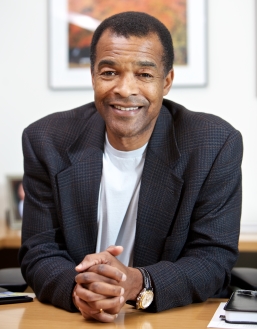Ken Denman: One step ahead of the innovation curve
The current Edward V. Fritzky Chair in Leadership, Ken Denman (MBA 1986), talks about his passion for leading edge technology, adapting to business cultures abroad and computers that can detect emotions.
 You’ve led at a string of successful tech companies. How have you navigated your course?
You’ve led at a string of successful tech companies. How have you navigated your course?
Well, I got my MBA from the Foster School in 1986, and I know I should probably have a more quantitative answer at the ready. But the truth of it is that I followed my passion. I wanted to be in on developing and launching technologies that would impact the way we work, live and play. I thought, “I need proximity to those kinds of businesses, that’s where the opportunity lies.” It’s built in to all the old adages: Why do people rob banks? That’s were money’s kept. Or, Go West young man! Essentially, all of these sayings are about aligning with opportunity.
Can you talk about some of the plans you have as Fritzky Chair?
Absolutely—I want to make the Foster School an even hotter bed of innovation than it already is. I organized a conference that focused on innovation and entrepreneurship. One of the sessions was called “Social 2018” and the presenter was Harvard Business Press author Nilofer Merchant—called “the female James Bond of innovation.” It’s a great example of my vision, which is to change the way we think about opportunity. We all know that the social era has changed the business landscape, and many of the old rules no longer apply. But the impacts are only starting to be realized. Corporate behemoths no longer have the advantage. Smaller, focused teams that are nimble and can conceive of an idea, make a plan and launch it from various points across the world, hold the edge.
The more exposure Foster students and faculty have to the different pieces of the innovation engine, the more prepared the upcoming generation of business leaders will be.
You seem pretty bullish on innovation—is there a downside of being on the cutting edge?
Recently, I’ve been thinking about how the things I’ve been involved in for the past 15-20 years have created jobs, but also contributed to the loss of existing jobs. How do we create enough work in the US? We’re going to be deeply challenged in this regard—the political talk about bringing jobs back isn’t likely to work. The economics aren’t pragmatic, and the kinds of skills needed will be very different.
The need to reorient our economy and educational aspirations is paramount. We need more knowledge workers, yes, but we have to push certain kinds of vocational training. One kind of job is going away, but there are new jobs enabled by that very technology. For example, maybe we need fewer machinists now, but what about the programmers and technicians who enable the machines? We don’t need to push everyone toward college, but the newer paths aren’t as clearly defined.
You’re currently CEO of Machine Perception Technologies. Can you talk about what the company is working on?
MPT is a software-based company working to merge emotion detection and machine learning to take personal technology to a new level. Emotion recognition is a logical progression toward the enhancement of applications like online education, e-commerce, gaming and market research. The ability of a device to discern your mood—are you confused, frustrated, angry?—will improve your experience by adapting to where you are.
Think about the billions of dollars spent on market research. Empirical evidence shows that people don’t tell the truth. Not because they’re trying to “lie,” but because of social biases, internal confusion, difficulty articulating feelings, etc. Think about the ability of cognitive recognition systems to account for this!
The power of this space is that the team we have for machine learning is a bunch of behavioral and cognitive scientists who are intent on getting machines to learn across a wide range of demographics. If you believe in this definition of artificial intelligence, you can say this is no longer science fiction. We’re working on how to extend the necessary processing power into the cloud so it can work on mobile devices.
What do you think is next for you?
The way I’ll get to the next thing is by following this line of inquiry I’ve had about the concept of adjacencies—analyzing “where good ideas come from,” not incidentally, the title of Steven Johnson’s great book on the history of innovation. Great innovations often come from previous innovations applied in non-obvious directions. I’ve been applying this notion to the mobile space and some of the other areas in which I’ve played to see if I can see what’s next. It’s a process.
Right now, this role (Fritzky Chair) is helping me focus, evaluate new ideas, and test my strategy. I’ve got a group of students flying down to my company to deliver the final readout of a field study focused on market entry strategy and competitive analysis. The students are absolutely amazing. I expect I’ll learn as much or more from them as they do from me.
The Edward V. Fritzky Chair in Leadership serves an academic year at Foster in an advisory role. This faculty position was specifically designed to put a distinguished business leader on campus to share their expertise with faculty and students.
